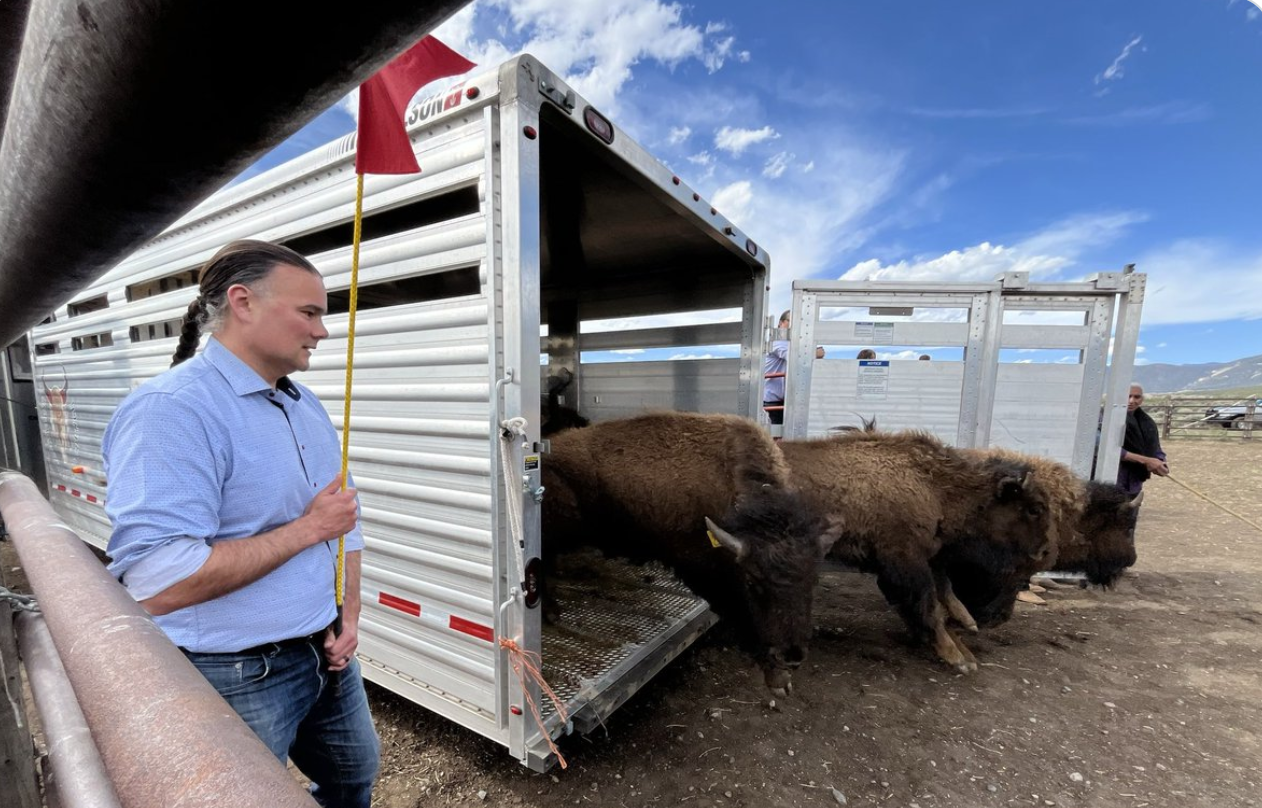
- Details
- By Native News Online Staff
Ten bison from Yellowstone National Park were released into the existing herd of buffalo on the tribal lands of the Taos Pueblo in New Mexico on Wednesday. On hand for the release was Assistant Secretary for Indian Affairs Bryan Newland (Bay Mills Indian Community).
Newland highlighted the significant funding the Interior Department has invested through President Joe Biden’s Investing in America Agenda to support the restoration of bison populations. In addition to the bison restoration, Newland highlighted the importance of grassland ecosystems in tribal communities.
In order to ensure grassland ecosystems, the Taos Pueblo is reestablishing native grasses through vegetation treatments that reduce the overgrown sagebrush canopy, helping to minimize nutrient and moisture competition. The new additions will add important genetic diversity to the Tribe’s existing herd of 100 bison.
The transfer was facilitated by the InterTribal Buffalo Council, which received $3.5 million to support its herd development and apprenticeship program created by Secretary’s Order 3410. The Council is a collection of 80 Tribes in 20 states that facilitates the management of more than 20,000 buffalo.
These activities advance the Department’s Grasslands Keystone Initiative, part of a restoration and resilience framework that is guiding $2 billion in investments from the Bipartisan Infrastructure Law and Inflation Reduction Act to restore lands and waters and advance climate resilience.
The Department currently manages 11,000 bison in herds across 4.6 million acres of U.S. public lands in 12 states. Last year, Secretary Haaland signed S.O. 3410, which is enhancing the Department’s work to restore wild and healthy populations of American bison and the prairie grassland ecosystem through collaboration among Department bureaus and partners such as other federal agencies, states, Tribes and landowners using the best available science and Indigenous Knowledge.
American bison once numbered 60 million in North America, with the population anchored in what is now the central United States. Many Indigenous cultures, especially in areas where the species was most abundant, developed strong ties with bison and relied upon them for sustenance, shelter, and cultural and religious practices.
More Stories Like This
50 Years of Self-Determination: How a Landmark Act Empowered Tribal Sovereignty and Transformed Federal-Tribal RelationsCherokee Nation Launches Digital Dictionary to Support Language Revitalization
Prairie Band Potawatomi Nation Chairman Addresses Homeland Security Contract
Lancaster County to Recognize Conestoga-Susquehannock Tribe on Massacre Anniversary
How the Gaming Economy Helps Tribes Navigate Shifting Policies
Help us defend tribal sovereignty.
At Native News Online, our mission is rooted in telling the stories that strengthen sovereignty and uplift Indigenous voices — not just at year’s end, but every single day.
Because of your generosity last year, we were able to keep our reporters on the ground in tribal communities, at national gatherings and in the halls of Congress — covering the issues that matter most to Indian Country: sovereignty, culture, education, health and economic opportunity.
That support sustained us through a tough year in 2025. Now, as we look to the year ahead, we need your help right now to ensure warrior journalism remains strong — reporting that defends tribal sovereignty, amplifies Native truth, and holds power accountable.
 The stakes couldn't be higher. Your support keeps Native voices heard, Native stories told and Native sovereignty defended.
The stakes couldn't be higher. Your support keeps Native voices heard, Native stories told and Native sovereignty defended.
Stand with Warrior Journalism today.
Levi Rickert (Potawatomi), Editor & Publisher


